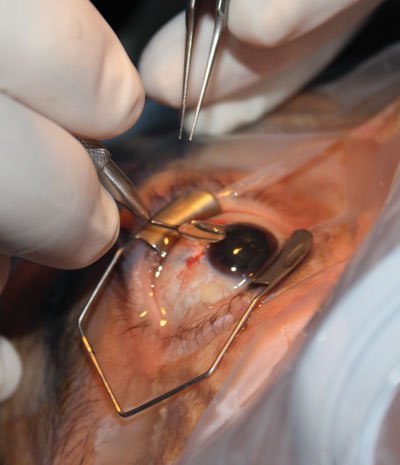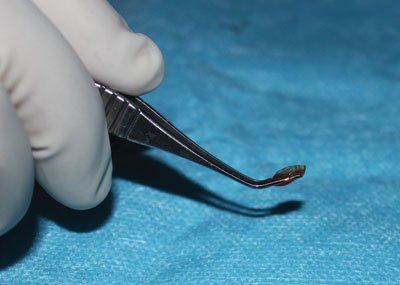Manual phacotrisection substantially reduces cataract extraction complications
A cataract surgeon explains why he has had good outcomes with few complications over the past 20 years.
From 1974 through 1991, I performed both conventional extracapsular cataract extraction and phacoemulsification. On more than one occasion, I experienced a complication when performing phacoemulsification that I felt would not have occurred had I simply performed my standard large-incision extracapsular procedure.
Frustration led me to adopt a manual, small-incision, lens trisection procedure, developed by Kansas, as my preferred cataract extraction technique. Over the past 20 years, I have performed approximately 15,000 manual phacotrisections in lieu of phacoemulsification. I have been extremely pleased with the relatively complication-free results.
The phacotrisection procedure begins with a 6-mm scleral tunnel, conventional capsulorrhexis and hydrodissection, which partially prolapses the nucleus. Subsequent insertion of a “cutting board” behind the nucleus is followed by sectioning the nucleus into three pieces with a hollow triangular trisector, which is passed down through the nucleus onto the cutting board (Figure 1). Removal of the trisector delivers the cleaved central nuclear fragment ensnared within the trisector blades (Figure 2). The remaining two lateral fragments are then sequentially removed with alligator teeth forceps. Manual irrigation and aspiration of cortex is followed by insertion of an unfolded IOL through the scleral tunnel, which is typically self-sealing.
 Figure 1. Intraoperative photo of phacotrisection. Images: Morin S
|
 Figure 2. Central nuclear fragment contained within the trisector. |
A review of my last 3,873 phacotrisection cases for the major complications of vitreous loss, endophthalmitis, dropped nuclear fragments and incisional burns yields the following complication rates:
- Vitreous loss: 0.75/100
- Endophthalmitis: 1/1,937
- Dropped nuclear fragment: 1/15,000
- Incisional burn: 0/15,000
While I pride myself as being a good surgeon, I do not view my skills to be extraordinary enough to account for these results. I believe phacotrisection provides inherent safety elements not present with other techniques and accounts for these low complication rates.
Safety elements
The first phacotrisection safety element is interposition of viscoelastic between the posterior nucleus and the capsule, which displaces the capsule well out of harm’s way throughout the nucleus removal procedure. No irrigation occurs during nucleus removal so the viscoelastic barrier stays intact and the capsule remains safely retro-displaced. The subsequently inserted cutting board lying between the posterior nucleus and the capsule further protects the capsule from injury. Additionally, the trisector does not have a sharp leading edge, and inadvertent contact with the capsule is a non-issue.
Secondly, phacotrisection dramatically reduces dropped nuclear fragments into the vitreous. The three relatively large nuclear fragments created by the trisection are simply too large to pass through the typical posterior capsule break. The fragments remain suspended in the anterior chamber even in the presence of a capsule disruption, and removal of these nuclear elements is easily accomplished.
As for endophthalmitis, a four-plane scleral tunnel with an internal locking valve offers a more secure wound closure when compared with a clear corneal incision. The low phacotrisection endophthalmitis rate speaks to the inherent safety of the watertight scleral tunnel closure.
Lastly, incision burn is inherently impossible with the manual procedure because the trisector and cutting board generate no heat. Additionally, the blunt cutting board and trisector pose no potential injury to the tunnel.
Another benefit and some drawbacks
An additional side benefit of employing a scleral tunnel with phacotrisection is that it allows for reduction of pre-existing corneal astigmatism by placement of the scleral tunnel at the greatest corneal curvature. Titration of the amount of corneal curvature relaxation is achieved by varying the wound architecture (smile/straight/frown incision, incision length, incision position relative to the limbus). No additional corneal weakening procedures to effect reduction of astigmatism are required. Glasses are typically prescribed at 2 weeks after surgery.
There are a couple of drawbacks to phacotrisection. Approximately 7% of patients require a 10-0 nylon suture to create a watertight closure of the tunnel, and approximately one in 200 patients needs to return to the operating room for suturing a leaking wound that was initially judged to be watertight. I view these as minor issues, far preferable to endophthalmitis, vitreous loss, incisional burn or a dropped nuclear fragment into the vitreous.
Phacotrisection offers a safe approach to cataract surgery. Its simplicity and reduced cost are also appealing in these difficult economic times. I am glad I switched.
For more information:
- Kenneth P. Wolf, MD, can be reached at Wolf Eye Associates, 249 Main St., Lewiston, ME; 207-783-9653; fax: 207-786-4362; email: mainewolfs@yahoo.com.
- Disclosure: Dr. Wolf has no relevant financial disclosures.
